I’m always amazed at the things I learn about dancers when I read these interviews, and today is no exception. Meet Dalia Rawson. Read her story. Be amazed. She’s one impressive lady…
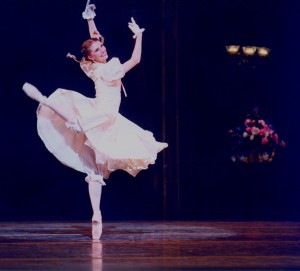
1. How did you become involved with dance?
The first time I ever moved might be considered dancing. I had been either very small or very still while my mother was pregnant with me. She says that late in the pregnancy she had never felt me move or kick. My parents had a season subscription to the Joffrey Ballet in NYC, and while watching the performance in the theater, my mother felt me move, apparently reacting to the music by kicking and rolling, for the first time. When I was a baby they called me twinkle toes, because I couldn’t keep still if there was any music playing. I was in local dance class by age two, a more serious ballet school at age six or seven, and San Francisco Ballet School at age nine.
2. What are you currently doing in the field?
Currently I choreograph and set ballets and I teach. I am the Artistic Director of The Rawson Project Contemporary Ballet, a small company I founded in 2010 for which I have created a small repertory of original works. I am also the Ballet Mistress of Ballet San Jose School where I teach all levels of the professional division, and Rehearsal Assistant for Ballet San Jose, for whom I run rehearsals and re-stage works.
3. Would you share a special moment from your career with readers?
That is a tough question, because it is hard to pick just one! I danced professionally with Ballet San Jose (formerly Cleveland Ballet) from 1991 to 2006, and that period of my life was filled with professional highs and lows, technical achievements, and chances to perform roles that I had dreamed of since my childhood. But the memories I treasure most are of those moments that were purely joyful; without pain, without politics, without jealousy, competition, or fear of failure. Dancing onstage allows you to live completely in the present moment and when that moment is joyful, there is nothing better.
My clearest childhood memory of the pure joy of performance dates back to the mid-eighties and San Francisco Ballet’s production of Balanchine’s A Midsummer Night’s Dream. As a child in the school who was chosen to perform with the company, I loved every second of that ballet. I remember being thrilled learning how to count Mendelssohn’s music, delighted that you could count three eights as an eight, and a nine, and a seven, in order to more precisely follow the melody. I fell in love with Karinka’s costumes, charmed by her sculptural use of layers in our “bug” costumes, and enchanted by the flowing silk dresses of the company fairies. The second year the ballet was performed I was chosen to be the first bug onstage! The curtain would rise revealing me posing in tendu devant, and I would get to start the ballet with a run and a grand jeté, my favorite step! I can still remember standing onstage at the San Francisco Opera House, counting the music of the overture before the curtain would come up with a rush of cold air and dust. I loved every second of those performances, from the first notes of the overture to the last seconds of the ballet, when all of the child dancers performing as “Oberon’s Retinue” or as we referred to ourselves, “bugs,” used a clever bit of stage magic to appear as fireflies for the ballet’s final tableau.
From my years of performing professionally, many joyful moments also remain etched in my memory. I will never forget my first dress rehearsal as an apprentice in the swan corps. I felt enchanted, and feeling almost magically compelled to dance to Tchaikovsky’s haunting score for Act II the historic steps I had seen so many times from the audience. It was overwhelming enough that I didn’t feel any ache in my feet while standing through the White Swan pas de deux. Unfortunately, that didn’t happen for all of the many swan corps performances of my career, which were often a misery. Standing still onstage is very painful, especially when your head is turned in such a way that you can’t even watch the dancing happening right next to you!
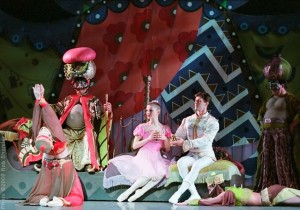
Many of my best memories involve interacting onstage with my fellow dancers, sharing the thrill of performance with true friends. A gorgeous blonde ballerina named Catharine Grow would hold me up on pointe using only the power of her enormous blue eyes during a tricky balance in my variation as the Russian Princess in Dennis Nahat’s Swan Lake. We had worked things out so that she would be sitting on a rock in the correct corner of the stage so that I could lock eyes with her when I had to perform a sustained relevé in arabesque. I could tell she shared my elation each and every time that we held that arabesque and our eye contact even longer than the music should have allowed. Cuban ballerina Patricia Perez and I were often paired together, being of similar height and temperament. In performance, we would egg each other on as only friends can, giving each other the confidence to take risks and push the limits of our technique, often to exciting results! I remember her screaming at me from the wings when I pulled off a triple pirouette both before and after fouettés in Nahat’s In Concert, her way of acknowledging both my achievement and our friendly competition to see who could do the most turns.
I am haunted by the memory of a moment that occurred during a performance of Balanchine’s Four Temperaments with what was then the Cleveland San Jose Ballet in Cleveland’s historic State Theater, probably in 1998. I danced the Melancholic trio with Nancy Latosewski and Shingo Yoshimoto, the realization of a childhood fantasy of doing those famous grand battements. One special moment from those performances stands out in my mind. I needed to get from stage left to stage right after the Melancholic section and before my entrance in the last movement. One night I found myself crossing behind the backdrop, directly behind center stage when the first few notes of the main theme of the Sanguinic Pas de Deux surged forth from the orchestra pit. I stopped and faced the orchestra pit and audience, behind the backdrop, letting the music wash over me. I hadn’t yet put on my warm-ups backstage, so there I stood, feeling vulnerable in just a black leotard, pink tights and pointe shoes. Knowing what was happening onstage mere feet in front of me but unable to see the dancers, I was overwhelmed by the power of the music. I stood there for a while, thankful that I was living my life as a dancer, then quickly hurried to the other side of the stage to put on legwarmers and watch my friends dance before my next entrance.
As my career progressed I danced bigger roles, but the extra pressure of a principal role sometimes seemed to take away the pure joy of dancing with my friends and colleagues. I was always very competitive, (I might have sold my soul to dance Juliet), and relished any chance to dance the great roles I had dreamed of as child. I am proud of what I was able to accomplish in those roles and remember dancing them with deep satisfaction. But looking back, I cherish the memories of being one of Swanhilda’s friends in Coppelia as much as memories of dancing Swanhilda. I realize now that the joy I drew from smaller roles was as profound as the sense of accomplishment I got from dancing bigger roles.
Now that I no longer perform, I find the process of watching my choreography onstage, or watching the accomplishments of my students, to be satisfying in a new way. As a choreographer, I have the ability to showcase the abilities the dancers that I work who can do things I never could have done myself. I love to choreograph for dancers with extreme flexibility or very long limbs, qualities I never had but coveted. Watching my students perform I get to feel the joy and pride of performance, without the exhaustion and pain of actually performing! I can’t seem to stop grinning when a student I trained pulls off a tricky turn or a difficult jump, or when the tiniest of students finds their mark correctly as a mouse in Nutcracker.
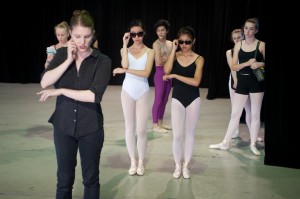
4. What is the best advice you have ever received from a teacher or mentor regarding dance?
Not to give up. When I was auditioning for companies, I remember my teacher Gloria Mohr telling me that I needed to audition for as many companies as I possibly could. Not just one or two or three, but ten or twenty or thirty. There are so many great dancers looking for work, especially women, so you have to put yourself out there over and over again in order to get lucky enough to find the director and the company that appreciates you. Now as a choreographer and director, I find the same thing applies to grant applications and choreographic opportunities. I apply aggressively for every opportunity that I come across. I often get turned down, but sometimes, an opportunity that I thought was out of reach comes through!
5. What has been your greatest challenge?
My performing career ended in 2006 when I was diagnosed with Hodgkin’s lymphoma. I had to go through a year of very intense chemotherapy and radiation treatment, culminating in a bone marrow transplant. I knew when I was diagnosed that it would be the end of my career as a ballerina, as I felt that at age 32 I was too old to be able to come back after treatment and recovery to anywhere approximating the level of technique I had achieved prior to my diagnosis. I was also told that tumors in my spine had caused damage that would make it dangerous for me to perform further strenuous physical activity. (This turned out not to be completely true as luckily my spine has healed quite well, and though it is not perfectly straight anymore, limiting my flexibility, I am perfectly capable of hard exercise.) Once treatment had finished, I struggled for a period to find a way to thrive as a non-dancer. I missed the daily camaraderie of company life, the ritual of class, the challenge of rehearsal, and the thrill of performance. I had never known anything else and felt lost.
Though I struggled for a few years internally, I went back to teaching as soon as I could, and began to find great joy in interacting with young dancers and being with them as they discovered for themselves what it means to love to dance. I choreographed for the Ballet San Jose School, and discovered a passion for choreography. I think a real turning point for me was when I decided to take surfing lessons! I spent a month learning to surf in Santa Cruz, and that led me to believe that new and exciting things were still possible for me. I eventually choreographed a ballet for Ballet San Jose, and started my own small company.
Recently I had my five-year checkup with my oncologists, and am pleased to say that I am officially “cured,” no longer “in remission.” Though my illness, treatment, and the subsequent changes in my life were a serious challenge for me, I am now once again busy, fulfilled and happy. At night I still dream of dancing, and of performing, but when I am awake I am happy to face new opportunities and challenges, and excited to explore and develop my love of dance further as a choreographer and a teacher.
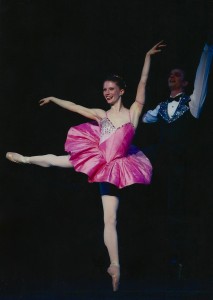
6. Do you have any advice for dancers who want to go on to a professional career?
If you know that you have to dance, there is a place for you to dance. It might not be the place you imagined for yourself, but it is out there. You have to keep trying, keep reaching, and not set any limitations on your dreams.
7. Do you have a special routine that you go through prior to a performance?
When I was dancing I was very strict with myself, almost superstitious. I would get to the theater hours early, only eat and drink specific things, prepare my shoes ritualistically, do Stephane Dalle’s floor barre, take class, and do my hair and makeup. Besides the floor barre (which is amazing, check out his website), the most effective thing that I did pre-show was a lot of visualization. This helped with nerves, and I think it also positively affected technical aspects of my performances. Thoroughly thinking through any upcoming dance, visualizing myself executing it perfectly while reminding myself of what I had to do to achieve anything technically tricky was a very powerful exercise.
Now it’s better! Barring unforeseen pre-show calamities that need my attention, I can usually go out to dinner with friends, and maybe even enjoy a glass of champagne.
8. Do you have any advice specifically for women in dance?
I would advise women especially to place a high value on their friendships with other dancers. It is really easy to let competition and jealousy get in the way of real friendship, but those connections are very valuable, and really important!
9. What do you enjoy most about your life in dance?
I can’t imagine my life without the ritual of class, the challenge of creation, and the thrill of performance. Now I want to pass these experiences on to my students, and celebrate them through my choreography.
10. What is next for you?
2012 will bring exciting new challenges! Ballet San Jose has recently announced a partnership with the American Ballet Theater, and I am anticipating great opportunities for the school as well as for the company. Students from our upper levels recently took a master class from Kate Lydon from the faculty of the Jacqueline Kennedy Onassis School, who visited our school with other ABT representatives in order to introduce our faculty, students and parents to the ABT National Training Curriculum. It was a pleasure to watch the children I have taught for the last ten years successfully share their talent with such a respected member of the international dance community. I am so proud of what we have accomplished so far at Ballet San Jose School, and really excited about what the future will bring.
The connections that will develop between our school and faculty on the west coast and ABT in New York through this partnership will be priceless. The students will certainly reap the benefits of further opportunities that will become available to them as the partnership with ABT for both our company and school develops.
The faculty of the BSJ School will soon be training to receive full certification in all levels of the ABT National Curriculum. I am looking forward to learning new skills through this program, and am inspired to have the chance to augment my abilities to teach a new generation of dancers. The curriculum consists of a comprehensive set of age-appropriate, outcome-based guidelines, consistent with the best practices in the fields of sports psychology, child/adolescent development, nutrition and training. These guidelines will provide an invaluable asset to the BSJ faculty when dealing with some of the common issues we in the dance world face, such as nutrition, the prevention of eating disorders and the maintenance of a healthy body image, as well as injury prevention. A medical advisory board collaborated on the development of the program and I believe the curriculum’s focus on the health of the whole dancer, not only their physical health but their mental and emotional health as well, will make the curriculum a great fit for our school, where providing personal attention and a caring atmosphere have always been among our highest priorities. I look forward to taking the steps that will make our great school exceptional, and anticipate that the ABT partnership will give me and the rest of our talented faculty exciting new tools with which to craft fine artists and valuable new connections through which to provide greater opportunities for our students.
In the summer of 2012, I will continue working on “No Longer Human,” a ballet I began working on with Ballet San Jose dancers funded by a Fellowship from the New York Choreographic Institute. An Applied Materials Grant from the Arts Council Silicon Valley provides funding for the completion of the choreography, as well as the construction of costumes for this work, which is a contemporary story ballet based on a Lithuanian folk tale set to an electronic score.
I always have new projects in the works for The Rawson Project Contemporary Ballet! I’m on twitter and facebook and have a frequently updated website, if anyone wants more information about my choreography or my company, or wants to keep up to date with what’s next!
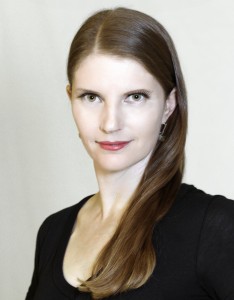
BIO: Recently awarded a Fellowship by the New York Choreographic Institute, Dalia Rawson is a contemporary ballet choreographer based in San Jose, California. From 1991 to 2006, Dalia performed a wide variety of leading roles as a dancer with Ballet San Jose, formerly Cleveland Ballet, under the artistic direction of Dennis Nahat. Rawson danced principal roles in Nahat’s The Nutcracker, Coppelia, and A Midsummer Night’s Dream, the heroine in comedies including Graduation Ball and Rodeo, dramatic roles in ballets such as The Lesson, Romeo and Juliet, and Carmen, principal and soloist roles in Balanchine works, and principal roles in modern masterworks including Donald McKayle’s Rainbow ‘Round my Shoulders and Martha Graham’s solo Frontier.
In January 2006, immediately following Ballet San Jose’s annual run of The Nutcracker in which she danced both leading roles, Dalia was diagnosed with advanced Hodgkin’s Lymphoma, ending her career as a ballerina. After a year of intensive treatment culminating in a Bone Marrow Transplant and five further years in remission, Dalia was recently officially pronounced cured of this disease.
Rawson returned briefly to the stage as a modern dancer with Moving Arts Dance during the company’s final season in 2010/2011. However, she now finds greater fulfillment as a choreographer and director. Currently, Rawson is Ballet Mistress of the Ballet San Jose School, Rehearsal Assistant for Ballet San Jose, and Artistic Director of The Rawson Project Contemporary Ballet. Her choreography has been performed both by Ballet San Jose and the BSJ School. Rawson’s ballet Fém debuted to critical and popular acclaim at the San Jose Center for the Performing Arts as part of BSJ’s 2008/2009 season. For her own company Rawson has created a repertory of award-winning ballets that have been performed locally and nationally at choreographic festivals, competitions, showcases, community events and charity fundraisers. She often works in collaboration with her brother Cliff Rawson, the Boston Conservatory trained composer and lead singer for the internationally acclaimed, post-punk band Ladycop. Their collaboration has lead to the creation of edgy, topical ballets that have appealed to a wide range of today’s audiences. For more information about the Rawson Project, please visit www.rawsonproject.org





I have had the pleasure of working with Dalia on many levels over the past couple of years and have grown to be good friends. She is an amazing woman and inspiration to be around. The Rawson project is a beautiful company that has brought and will bring many beautiful dance moments to the stage.
Thank you for this lovely article!
Thank you for “10 Questions with Dalia Rawson” as I’ve enjoyed many of her choreographic works over the past few years. While it confirms that I indeed missed out by never having seen her dance professionally, it provides an insightful look into why her passion shows through in all her dancer’s performances. Thank you.
Thanks Scott and John!
Thank you also 4dancers for letting me share my story. After posting your article on my personal facebook page I got an amazing response from dancers who were reminded by this post of our time on stage together! Thanks for the opportunity to reconnect with people from my past, as well as the chance to talk about what I’m doing now.